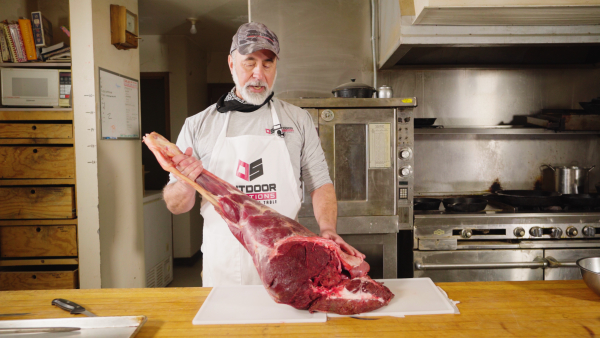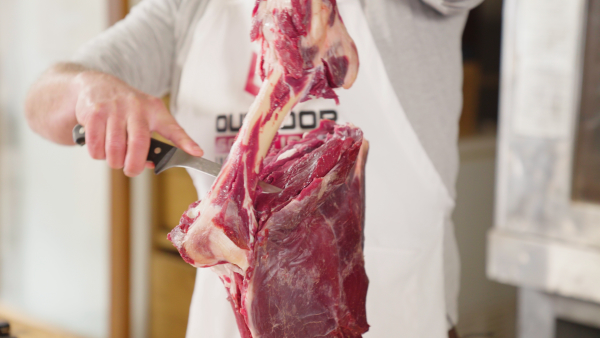THIS IS SOMETHING NEW I PLAN TO INCLUDE FROM THE GROUP CALLED “OUTDOOR SOLUTIONS”. HOPE YOU ENJOY IT.
PART I – Field Care, Factors That Affect Taste and Tenderness

(Intro) Cooking wild game can be challenging for even the most seasoned home cook. Many non-hunters cite a “funny” or “off” taste to wild game, but using appropriate field care, butchering and cooking techniques, wild game can be tastier than store bought, grass-fed, organic meats. In this first of a four-part series from professional chef Albert Wutsch, we take a look at his expert advice on proper wild game handling techniques along with details on cooking wild game. Wutsch serves as the guest chef at Outdoor Solutions’ Field-to-Table culinary events. Chef Wutsch is also a culinary educator and regularly writes for publications and has published several books.
As a professional chef that specializes in cooking game, my objective is to take the mystery out of cooking wild game meat. Once you understand the factors that affect taste and tenderness from field to table, you will be more than well on your way to better utilizing your game and having your entire family enjoy the fruits of your harvest.

Many factors affect taste and tenderness from the field to the cutting board. The first and probably one of the most important factors is the age of the animal. It’s very simple, the younger the animal the more tender it is going to be. Let’s use beef and veal as an example, same animal-different age. Beef is slaughtered between 18-24 months; veal is less than six months. That makes beef equivalent of a spike bull elk or young deer. Look at the difference between the color of the meat of beef versus veal, the fat content and color, and the taste. So for those hunters that are seeking to harvest a mature buck at 4-5 years old, consider that an old stewing hen that we throw in the pot and cook the heck out of to make tender. In short, younger animals eat better and they’re usually a lot easier to come by.
A deer that eats grain and corn tastes different than one that lives off browse from the north woods or lives in the sage brush. A duck that eats fish tastes differently than a duck that eats vegetation. Try to pair the flavor of these meats with a recipe that complements that flavor. If you feel your antelope tastes like sage, then incorporate it into breakfast sausage. If your duck tastes like fish, incorporate it into a Thai dish that uses fish or oyster sauce.
How the animal is harvested effects tenderness. Was the animal harvested quickly, dead-and-bled all in one shot or was the animal wounded and ran five miles before retrieving it? Was the elk in full rut when he hasn’t eaten for three weeks, been protecting his harem and you can smell him from 300 yards away? These natural factors do affect the taste and tenderness of the meat on the plate. Shot placement is another factor that affects taste and yield. Poor shot placement will create more work when processing and will result in a poor yield of quality meat.

The objective of field dressing other than to remove entrails, is to lower the body temperature as quickly as possible. Whether you field dress or use the gutless method, the goal is the same: lower the body temperature. Skin on or skin off? I recommend skin off ASAP, as it comes off much easier while warm. If the hide stays on for more than 24 hours, it requires much more knife work and pulling which sometimes results in cuts and bandages. On large animals such as elk, moose, and bear, they have large muscle mass, thick fat cover, heavy hides and fur that will hold body temperatures and could sour meat overnight. To protect meat from getting dirty, place meat in breathable game bags, not plastic. Utilize the hide as a protective table. Always cut from under the hide to lessen the amount of hair that you get on the meat and be especially careful with antelope, as their hair comes off in handfuls.
Sometimes the animal is gut shot or you accidently open the paunch when field dressing and it spills into the interior of the cavity, leave it alone. There is a natural skeletal barrier between the inside and the meat on the outside. Just remove the muscles from the outside of the skeleton and leave the contaminated inside alone. This prevents spreading of the contamination. Don’t throw the carcass in the creek or try to wash because your only spreading contamination from the inside to the outside onto all the meat. If you want to wipe the meat off I recommend using some vinegar water and a clean towel. Always cut off all bloodshot before aging or else the blood will permeate the muscles and sour more than you planned for.
Always be careful and inspect your animal before field dressing so you know what to expect when you get in there. You don’t want to be surprised by a broad head or anything else. Be careful not to touch the tarsal gland then the meat. You don’t want a foul tarsal gland rub on the meat. Don’t spill the bladder or the anal track on the tenderloins. If you shoot an antelope in the sage brush, field dress it and drag through the sage brush and then hang and age for a week, what’s it going to taste like? So be careful what goes on the meat before aging.

These are issues we are faced with every time we go afield. We need to be as prepared to handle the meat with sharp knives, game bags, pack frames, ice chests, even cutting boards, as we are with our optics, ammo, and scent block.
Our goal is to get good, wholesome quality meat from the field to the table for everyone to enjoy the fruits of your harvest.
Good Cooking, Chef Wutsch
You may also like
-
VENISON ENCHILADAS CREATED BY: JENN DANELLA-HOMA | JENN’S WILD GAME KITCHEN
-
FRIED BACKSTRAP WITH SPICY REMOULADE DIPPING SAUCE from Timber 2 Table in Realtree Newsletter
-
CAJUN CABBAGE JAMBALAYA WITH GROUND VENISON from Timber 2 Table in Realtree Newsletter
-
TESTING THE .50-CAL UMAREX HAMMER
-
Wild Game Cooking Gear For Beginners by Remington

